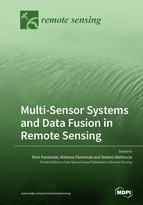Multi-Sensor Systems and Data Fusion in Remote Sensing
A special issue of Remote Sensing (ISSN 2072-4292). This special issue belongs to the section "Remote Sensing Image Processing".
Deadline for manuscript submissions: closed (30 June 2021) | Viewed by 38173
Special Issue Editors
Interests: multi-sensor data fusion; statistical estimation; integrated navigation systems; simultaneous localization and mapping; synthetic aperture radars; unmanned aerial systems
Special Issues, Collections and Topics in MDPI journals
Interests: remote sensing; echolocation; ultrawideband radar systems; antenna technology; sensor modelling; acoustoelectronic devices; unmanned ground vehicles
Interests: computer vision; machine-learning; 3D vision; embedded computer vision
Special Issues, Collections and Topics in MDPI journals
Special Issue Information
Dear Colleagues,
The remote sensing of today is developing at a rapid pace due to the technological progress in many interconnected fields. It includes emergence of new sensors and refined and more capable traditional sensors, development of more and more sophisticated space, aerial, and ground platforms for mounting those sensors, as well as advances in signal and data processing algorithms. The technological progress in the fields of radar, optoelectronic, acoustic, magnetic, chemical and other sensors is really stunning. Whereas the mentioned sensors are currently more and more sensitive and accurate, have improved resolutions, data rates, and dynamical ranges, they still have their intrinsic deficiencies and limitations. Utilization of multi-sensor systems and joint processing of their signals or data has long been considered an effective solution for reducing the mentioned disadvantages and making the best use of their strengths, this way leading to a synergy effect. Emergence of new types of cutting-edge-technology sensors creates an excellent opportunity for scientists and engineers to propose and develop new and more capable integrated multi-sensor systems. At this point it is necessary to mention that the users’ demands and expectations with respect to the size of the observed area or volume, data resolution, accuracy, speed of operation, and functionality of remote sensing systems are still increasing. Extended frequency bands, improved resolutions and data rates of the new sensors as well as more and more common use of systems composed of many spatially distributed sensors increase the influx of data in contemporary multi-sensor systems. The above facts pose new challenges for the data fusion algorithms which must often employ the newest techniques and achievements from the areas of big data mining, statistical estimation, artificial intelligence, and the other concepts that have recently come to light. Therefore, it would be of great interest to the remote sensing community to have a fresh insight into the newest developments in the fields of multi-sensor systems and data fusion. We would like to invite you to submit theoretical or application-oriented papers presenting new developments including, but not limited to the following topics:
- Multi-sensor remote-sensing systems in the Earth science, environmental monitoring, robotics, transportation, industrial process monitoring, security and military applications
- Unconventional multi-sensor solutions
- Spatially distributed networks of sensors
- Distributed signal and data processing
- Multi-sensor data fusion on raw data level, feature level and decision level
- Statistical estimation in remote sensing
- Artificial intelligence in remote sensing
- Big data processing in remote sensing
- Machine learning in remote sensing
Prof. Dr. Piotr Kaniewski
Prof. Dr. Mateusz Pasternak
Prof. Dr. Stefano Mattoccia
Guest Editors
Manuscript Submission Information
Manuscripts should be submitted online at www.mdpi.com by registering and logging in to this website. Once you are registered, click here to go to the submission form. Manuscripts can be submitted until the deadline. All submissions that pass pre-check are peer-reviewed. Accepted papers will be published continuously in the journal (as soon as accepted) and will be listed together on the special issue website. Research articles, review articles as well as short communications are invited. For planned papers, a title and short abstract (about 100 words) can be sent to the Editorial Office for announcement on this website.
Submitted manuscripts should not have been published previously, nor be under consideration for publication elsewhere (except conference proceedings papers). All manuscripts are thoroughly refereed through a single-blind peer-review process. A guide for authors and other relevant information for submission of manuscripts is available on the Instructions for Authors page. Remote Sensing is an international peer-reviewed open access semimonthly journal published by MDPI.
Please visit the Instructions for Authors page before submitting a manuscript. The Article Processing Charge (APC) for publication in this open access journal is 2700 CHF (Swiss Francs). Submitted papers should be well formatted and use good English. Authors may use MDPI's English editing service prior to publication or during author revisions.
Keywords
- Remote sensing
- Multi-sensor systems
- Multi-sensor data fusion
- Sensor networks
- Multi-sensor signal processing
- Multi-sensor data processing
- Artificial intelligence
- Big data mining
- Machine learning
- Distributed processing








